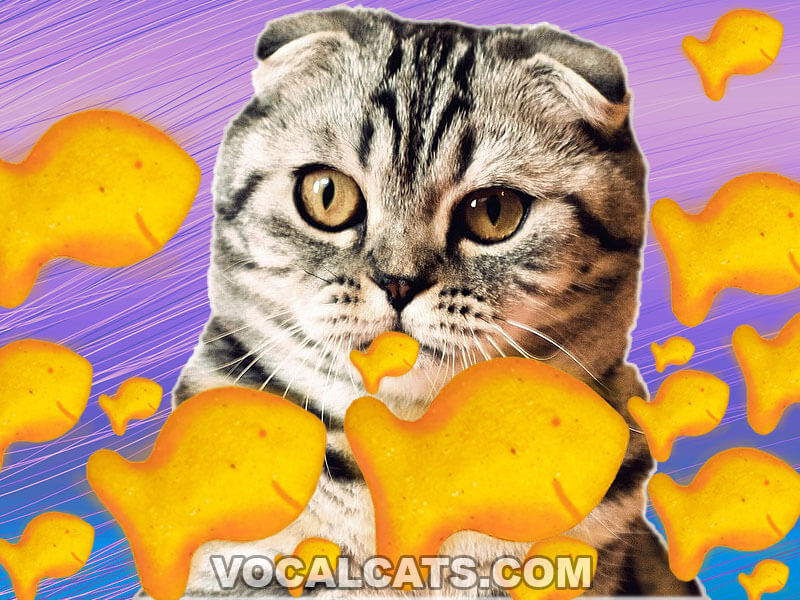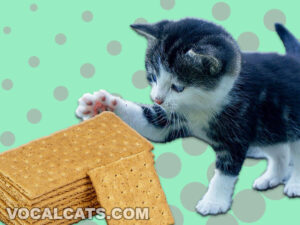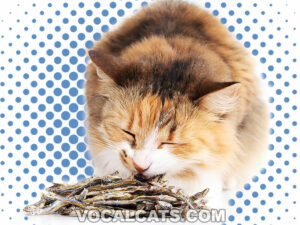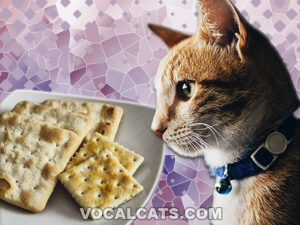Can Cats eat Goldfish Crackers? No, cats should not eat Goldfish Crackers as this human snack is packed full of ingredients that are not feline-friendly including high sodium content. Goldfish Crackers also contain fat, oil, and additives, all of which are not healthy for cats. Luckily, Goldfish Crackers are not toxic to cats so don’t panic if you find your fuzzy friend stealing a Goldfish Cracker or two.
You’re snacking on some Goldfish Crackers when you find your fluffy companion sitting next to you and putting her paws on your arm. As a feline owner, you know she’s trying to do. She is begging you to share some of those Goldfish Crackers. But should you?
If you’re wondering, “Can I give my cat Goldfish Crackers?” then you’ve landed on the right page. In this comprehensive article, we’ll discuss why it is not safe to share your Goldfish Crackers with your feline friends, how the ingredients in this cheddar snack can negatively impact your cat’s health, and provide some feline-friendly snacks you can give your kitties instead.
RECOMMENDED: Can Cats Eat Graham Crackers?
Contents
- Can cats have Goldfish Crackers?
- What Are Goldfish Crackers?
- Are Goldfish Crackers bad for Cats?
- Is it normal for my cat to eat Goldfish Crackers?
- Cat ate Goldfish Crackers! What should I do?
- Healthy alternatives to Goldfish Crackers that are feline-friendly and safe
- Food for cats with sensitive stomach
- So, can cats eat Goldfish Crackers?
Can cats have Goldfish Crackers?
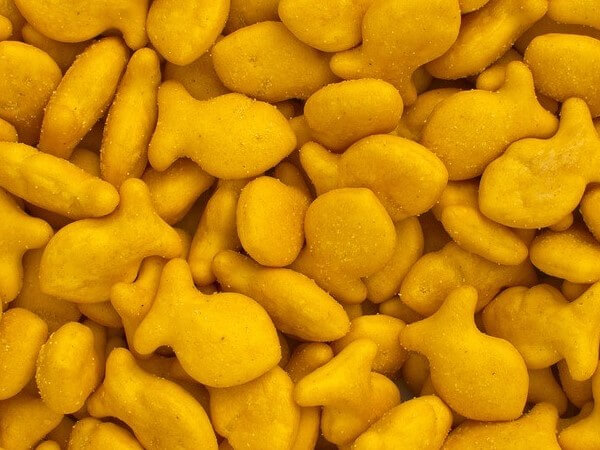
No, cats should not have Goldfish Crackers. Before you offer a Goldfish Cracker or two to your feline friends, you’ll want to know the ingredients in Goldfish Crackers first and find out whether your fuzzy friends are allergic to any of them.
We also highly recommend that you consult with your vet first before feeding Goldfish Crackers to your cats. Your vet should know the health of your feline companions and will inform you of any allergies your kitties may have.
It’s also important to note that if your feline friends do get into a bag of Goldfish Crackers and stole a cracker or two, you’ll want to monitor them closely for the next few hours and find out about how many Goldfish Crackers they consumed and whether they’re having any allergic reactions.
In general, if your cat is not allergic to any of the ingredients in Goldfish Crackers and have only consumed a small amount, he should be fine since the ingredients in Goldfish Crackers, in small amounts, won’t do much harm to your kitty cats. In this case, it’s very likely that your fuzzy companion won’t experience any negative reactions.
As you can see, it really boils down to what Goldfish Crackers are and the ingredients in this snack. Knowing what Goldfish Crackers are made of will help you to fully understand why our cats should not eat Goldfish Crackers and why we should keep this human snack away from their reach.
So, what are Goldfish Crackers made of? Let’s find out next.
RELATED: Can Cats Eat Animal Crackers?
What Are Goldfish Crackers?
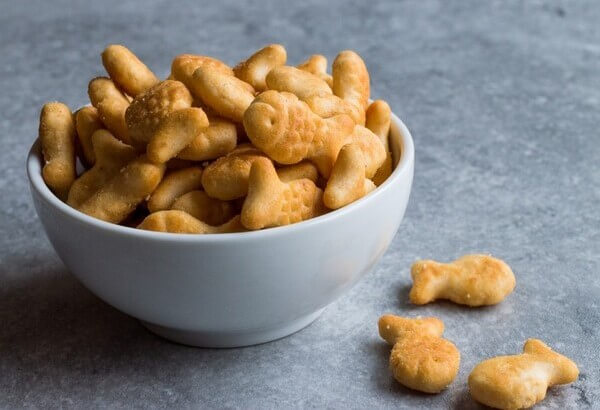
First, let’s clarify that Goldfish Crackers are not actual Goldfish at all. Although Goldfish Crackers are shaped like small fishes, they are not actual fish.
Goldfish Crackers are simply baked Crackers that are shaped like small fishes with a smile and little eyes and are yellow in color (we’ll discuss what ingredient gives the Goldfish Crackers the yellow color in a bit).
Goldfish Crackers are one of the most popular cheese crackers here in the US. Today, Goldfish Crackers come in a variety of flavors including pretzel, pizza, nacho, parmesan, ranch, vanilla cupcake, and the original cheddar flavor to name a few.
So, what are the ingredients in Goldfish Crackers? Read on to find out!
Goldfish Crackers ingredients
When determining whether certain food or snack is healthy or safe for feline-consumption, it’s crucial that cat owners take a look at the ingredients first.
When reading the ingredients, the first three ingredients are the primary ingredients. The ingredients are always listed by quantity.
For instance, the first ingredient on the list is what the manufacturer used the most of or the highest amount. The last ingredient on the list means that that particular food contains the lowest amount of that ingredient.
If we take a look at the ingredients in the original Goldfish Crackers, we’ll see the following ingredients:
- Enriched wheat flour (flour, niacin, reduced iron, thiamine mononitrate, riboflavin, folic acid).
- Cheddar cheese ([cultured milk, salt, enzymes], annatto).
- Vegetable oils (canola, sunflower and/or soybean).
- Salt.
The original Goldfish Crackers also contains 2% or less of the following:
- Nonfat milk.
- Yeast.
- Sugar.
- Baking soda.
- Monocalcium phosphate.
- Paprika.
- Spices.
- Celery.
- Onion powder.
As we skim through this ingredient list, we can see that Goldfish Crackers are not made for feline consumption and are not cat-friendly. We can also see that are there are some ingredients in Goldfish Crackers that are harmful to our fuzzy friends.
RELATED: Can Cats Eat Celery?
Additionally, let’s take a look at the nutritional profile of Goldfish Crackers.
Nutritional Profile of Goldfish Crackers (1 serving size, 55 pieces, 30g)
| Name, Unit | Amount |
| Calories, cal | 140 |
| Total Fat, g | 5 |
| Saturated Fat, g | 1 |
| Cholesterol, mg | 10 |
| Sodium, mg | 250 |
| Total Carbohydrate, g | 20 |
| Protein, g | 3 |
| Calcium, mg | 40 |
| Iron, mg | 1.3 |
| Potassium, mg | 50 |
| Thiamin, mg | 0.15 |
| Riboflavin, mg | 0.17 |
| Niacin, mg | 2.3 |
| Folate, mcg | 75 |
| Folic acid, mcg | 45 |
In a single serving of Goldfish Crackers (or 55 pieces), there are 140 calories, 5 grams of fat (1 grams saturated), and 20 grams of carbohydrates. As we can see, there is about 40% fat in just 1 serving size of Goldfish Crackers.
If you allow your feline companions to munch on this crunchy cracker, it’s like feeding them raw fat. While eating one or two Goldfish Crackers is fine, consuming too many will cause your cats to experience negative health effects.
Are Goldfish Crackers bad for Cats?
Yes, Goldfish Crackers are bad for cats. It’s best that we do not feed our feline friends Goldfish Crackers. If your kitties stole a few Goldfish Crackers, you’ll want to monitor them closely for the next few hours and watch for any changes in behavior.
Let’s see why Goldfish Crackers are bad for Cats next. We’ll go through each of these ingredients to see how they can negatively affect your kitten’s health.
Harmful ingredients in Goldfish Crackers
Enriched wheat flour in Goldfish Crackers does not provide any nutritional value to cats
Looking through the ingredient list, we can see that enriched wheat flour is the first ingredient listed. As mentioned above, the first item on the ingredient list, enriched wheat flour, is used the most, so it’s not surprising that Goldfish Crackers are made mostly of wheat flour.
Hence, if your cat is sensitive to wheat or has wheat or gluten allergy, you’ll want to keep Goldfish Crackers away from him or her.
In general, our fuzzy friends don’t need or require grains like wheat in their diet. Cats are “obligate carnivores” so they thrive best on a meat-based diet or a protein diet.
It’s also important to point out that the wheat used to make Goldfish Crackers is not 100% whole wheat. The reason why it’s called enriched wheat flour is because all the natural nutrients you would find in a 100% whole wheat have been stripped away.
To add the healthy nutrients back into the wheat flour, the manufacturers would then add in niacin, reduced iron, thiamine mononitrate, riboflavin, and folic acid.
Evidently, enriched wheat flour is a refined grain and it is highly processed. This means that this type of wheat flour is known as simple carbohydrates and even if your felines are not allergic to wheat or gluten, the enriched wheat flour used to make Goldfish Crackers would provide no nutritional value to our kitties.
In some cases, consuming Goldfish Crackers can even briefly spike your cat’s sugar level. This can cause your cat to be quite energetic for a short period before they experience a crash in energy level.
It’s best that you do not feed your cats Goldfish Crackers because enriched wheat flour is considered empty carbs. This means that our fuzzy friends would increase their calorie intake without receiving any nutritional benefits. Not only can this lead to weight gain and eventually obesity and diabetes in the long term, but also digestive issues in cats.
Many would argue that the added B vitamins such as niacin, thiamine mononitrate, riboflavin, and folic acid in the wheat flour would benefit our feline friend’s health since B vitamins are essential for energy production and proper growth and development in cats.
However, our feline companions can get these B vitamins, iron, and other nutrients from their regular feline food and cat-friendly treats.
High sodium content in Goldfish Crackers can lead to salt poisoning in cats
In just one serving or 55 pieces of Goldfish Crackers, there are 250 mg of sodium. While this may not seem like a lot of salt to us, this is considered a lot of salt intake for our feline friends.
When it comes to our fuzzy friends, about 21 milligrams to 42 milligrams of salt each day is generally safe for cats. If your kitties consume more than 42 milligrams of salt, they may experience sodium poisoning.
Signs and symptoms of sodium poisoning includes:
- Loss of appetite.
- Vomiting.
- Diarrhea.
- Extreme thirst.
- Frequent urination.
- Loss of coordination.
- Disorientation.
- Feeling lethargic.
- Muscle weakness.
- Tremors.
- Seizures (in severe cases).
- Coma (in severe cases).
- Death (in severe cases).
As we can see, feeding your fuzzy kitties a diet that is high in salt can not only negatively affect their digestive system but also their overall health.
If you notice or suspect your feline companions have sodium poisoning as a result of eating Goldfish Crackers, we highly recommend that you call your vet right away. Sodium poisoning in cats is serious and requires immediate medical attention.
This is why it’s important that cat owners do not leave an open bag of Goldfish Crackers sitting on the dining room table or on the kitchen counter. Our fuzzy kitties are curious creatures and they will sniff out the snacks we leave open and exposed around our house.
If our kittens find an open bag of Goldfish Crackers, they may not think twice before stealing some Goldfish Crackers. This can become dangerous as 1 bag of Goldfish Crackers contain 250 mg of sodium and this is way above the safe range of 21 milligrams to 42 milligrams of daily salt limit.
Simply consuming eight (8) to nine (9) Goldfish Crackers could put our feline friends at risk of salt poisoning.
For these reasons, it’s a good idea to seal and put away any unfinished bag of Goldfish Crackers.
SEE ALSO: Can Cats Eat Saltine Crackers?
Cheddar cheese in Goldfish Crackers contain annatto vegetable dye which is harmful to cats
When we take a look at the ingredients used to make cheddar cheese in Goldfish Crackers, we see that it is made of cultured milk, salt, enzyme, and annatto.
What’s different about cultured milk as compared to plain milk is that it contains less lactose, the sugar found in milk. This means that most cats can safely and properly digest cultured milk and other cultured dairy products like sour cream, buttermilk, and yogurt.
However, we need to be mindful of the fact that cultured dairy products like cultured milk may be packed full of sugars and additives which is extremely unhealthy for our feline friends.
As you’re skimming the ingredients, you’re probably wondering what annatto is. Let’s go over what annatto is and how it can affect your kitty cats.
Annatto is what gives the Goldfish Crackers that orangey-red color. That’s because annatto is an orangey-red vegetable food dye that is often used to color cheese and other types of foods.
In fact, The Washington Post reported that annatto can cause seizures in some animals so be careful when feeding any food that contains annatto in them.
We also see salt used to make cheddar cheese. Therefore allowing your furry kitties to eat more than a few Goldfish Crackers can also lead to sodium poisoning.
Both of these reasons are why we should not feed our cats Goldfish Crackers.
Some vegetable oils used to make Goldfish Crackers are not healthy for cats
The vegetable oils used to make Goldfish Crackers include canola oil, sunflower oil, and soybean oil.
When it comes to canola oil, did you know that this name is short for CANadian + Oil + Low Acid. There are mixed messages about feeding your feline friends canola oil.
On one hand, Dr. Jeannie Thomason, a veterinary naturopath states that canola oil is not safe for feline consumption because rapeseed, which is processed to make canola oil is actually toxic and can form a latex like substance in the blood and this can lead to damage in the animal’s nervous system, constipation, blindness, respiratory problems, and even anemia.
On another hand, Dr. Susan Wynn, a veterinarian, noted that giving your cat organic canola oil is fine because it contains omega -3 and omega-6 fatty acids.
Sunflower oil is safe to give our felines, however, make sure to offer a moderate amount. Too much sunflower oil consumption can actually lead to weight gain in cats.
Similar to sunflower oil, cats can safely consume soybean oil. However, make sure your feline friends only consume a small or moderate amount of soybean oil.
Onion powder in Goldfish Crackers is extremely toxic to cats
Seeing that onion powder is listed in the ingredients it gives us enough reasons to not feed our cats Goldfish Crackers.
Although Goldfish Crackers contain 2% or less of the onion powder, any ingestion of onion is dangerous to cats. Onion in all forms, whether raw, dehydrated, powder, fried, or cooked is bad for our feline companions.
That’s because onion or onion powder contains two compounds that are toxic to cats if ingested. They are thiosulphates and disulfides. When our fur babies ingest onions in any form, they may start to experience one or all of the following:
Hemolytic anemia in cats
Hemolytic anemia is a disease that appears in cats when there is a loss of red blood cells. Either their body is incapable of producing new red blood cells or the disease reduces the number of the cells.
Cats with hemolytic anemia may experience symptoms such as loss of appetite, muscle weakness, lethargy, and pale mucous membranes.
Heinz body anemia in cats
Heinz body is a type of anemia in cats. When they ingest onion (no matter if it is raw or powder), it can damage their red blood cells and this leads to Heinz body anemia.
Symptoms of this type of anemia include the following:
- Sudden muscle and body weakness.
- Lack of appetite (anorexia).
- Skin discoloration.
- Pale lips, gums, and mouth.
- Fever.
- Lethargy.
- Rapid breathing (Tachypnea).
- Fast heart beat (Tachycardia).
- Dark urine (in severe cases).
Other than consuming toxins such as onion, garlic, kale, wilted red maple leaves, zinc, and turnips, our fluffy friends can also get Heinz body anemia by ingesting certain types of medications. Other causes include lymphoma, hyperthyroidism and diabetes.
Methemoglobinemia in cats
When our fuzzy kitties ingest onion, garlic, or other toxins we’ve listed right above, they may also have methemoglobinemia. Signs and symptoms of methemoglobinemia in cats include the following:
- Vomiting.
- Excessive drooling.
- Skin discoloration.
- Pale lips, gums, and mouth.
- Swollen face.
- Muscle or body weakness.
- Loss of coordination.
- Hypothermia.
- Jaundice.
- Rapid breathing (Tachypnea).
- Fast heart beat (Tachycardia).
- Depression.
- Coma (in severe cases).
- Passing away (in severe cases).
The two compounds mentioned above can cause the red blood cells to become very weak and fragile. When red blood cells are weak and fragile, they can burst easily and this eventually lead to damage in red blood cells.
Keep in mind that onion powder is three times more potent and intense than fresh onion. Just a small amount of onion can cause onion poisoning in cats. You’ll also want to know that cats are more sensitive to the negative effects of onions than dogs.
In fact, it takes as little as 5g/kg of onion to cause red blood cell damage in cats.
Some signs and symptoms of onion toxicity include:
- Diarrhea.
- Vomiting.
- Difficulty breathing.
- Rapid breathing.
- Yellow, brownish, or pale gums.
- Increased heart rate.
- Urine discoloration.
- Abdominal pain.
- Feeling lethargic.
If you suspect your fuzzy companion has onion poisoning, we highly recommend that you contact your vet right away or call the Pet Poison Helpline at 855-289-0358 if you’re not able to reach your vet. Onion toxicity is a serious health issue and requires immediate medical attention.
READ NEXT: Can Cats Eat Takis?
High calorie content in Goldfish Crackers can lead to weight gain and obesity in cats
We can see from the nutritional profile of Goldfish Crackers above that 1 serving size or 55 pieces of Goldfish contain 140 calories.
Now, you may be thinking, “Well, I’m obviously not going to feed my cats a whole bag of Goldfish Crackers!”
With that, let’s see how many calories are in just one Goldfish Cracker:
Nutritional Profile of Goldfish crackers (1 piece, 0.5g)
| Name, Unit | Amount |
| Calories, cal | 2.5 |
| Total Fat, g | 0.1 |
| Sodium, mg | 4.8 |
| Total Carbohydrate, g | 0.4 |
| Protein, g | 0.1 |
| Calcium, mg | 0 |
| Iron, mg | 0 |
| Potassium, mg | 1.1 |
Just one piece of Goldfish Cracker contains 2.5 calories, 0.1 grams of fat, and 0.4 grams of carbohydrates. Allowing your feline friends to ingest one to three Goldfish Crackers is fine but make sure they aren’t consuming any more than that.
If your kitties consume lots of Goldfish Crackers, they are at risk of weight gain and feline obesity. Obese cats can experience the following negative health effects:
- Reduced insulin sensitivity.
- Develop hyperinsulinemia.
- Increase in plasma leptin concentrations.
- May be at risk of overt type II diabetes mellitus.
- Increased risk for pancreatitis.
Is it normal for my cat to eat Goldfish Crackers?
Some cats love to nibble on cheesy, salty, or crunchy food and Goldfish Crackers fit all of this criteria. While offering one or two Goldfish Crackers to your feline companion every now and then is fine, it’s not a good idea to give your feline friends Goldfish Crackers every day.
Cat ate Goldfish Crackers! What should I do?
If your cat ate Goldfish Crackers, don’t fret!
First, you’ll want to find out how much of the Goldfish Crackers he consumed and at approximately what time he consumed the Goldfish Crackers. You’ll want to write down the number of Goldfish Crackers consumed and the time they were consumed on a piece of paper.
Next, carefully observe your feline friend and check for any changes in behavior or for any signs or symptoms we’ve discussed above. If you do suspect signs of salt toxicity or onion toxicity, you’ll want to call the vet immediately.
Your vet may ask that you bring your cat in for a physical checkup or a thorough examination where they will perform a series of tests to determine the severity of the toxicity. This is also when you should inform the vet of the information you wrote down as well as your cat’s age and any existing health issues.
If you’re not able to get a hold of your vet, don’t hesitate to call the Pet Poison Helpline at 855-289-0358.
In most cases, there is no need to worry as your cat may simply be quite thirsty with a case of flatulence that may occur for a few hours, or an upset stomach.
In severe cases, you may have to drive your kitten to the nearest veterinary hospital. Depending on how severe the symptoms or toxicity is, your furry friend may have to stay at the veterinary hospital overnight.
In some cases, if the salt toxicity is quite severe, your cat may have to stay at the hospital for several days. That’s because the salt level will need to be brought down to a normal level slowly or gradually. Additionally, a blood transfusion may be required.
With that said, it’s best to keep Goldfish Crackers away from our fuzzy friends.
Healthy alternatives to Goldfish Crackers that are feline-friendly and safe
There’s no doubt that our feline companions love cheese treats and snacks. Instead of giving them Goldfish Crackers, it’s best that we give them feline-friendly cheese treats such as these ones below.
Food for cats with sensitive stomach
Does your cat vomit or cough right after having a regular meal? If so, then it may be that he has a sensitive stomach.
One of the reasons for gastrointestinal problems is poorly digestible foods. Often speaking with your vet and coming up with a proper diet plan for your fluffy kitties can address the upset stomach issue.
Pet lovers must keep in mind that vomiting might be a sign of other illnesses other than a sensitive stomach.
The best approach is to speak with your kitties’ vet and seek their professional advice. Once at the veterinary hospital or office, your vet will perform a thorough physical examination as well as medical tests such as blood tests and x-rays to find out what is causing the stomach issues and if there are other health-related problems.
Here are some recommended foods for your cat dealing sensitive stomachs.
So, can cats eat Goldfish Crackers?
As we can see, cats should not eat Goldfish Crackers. However, if they do get a hold of some Goldfish Crackers, there is no need to panic. Follow the steps provided above and be sure to stay calm.
Our cats’ health and safety is one of our main priorities and it’s best that we give them feline-friendly treats instead of human snacks like the Goldfish Crackers.
If there’s one thing to take away from this article, it’s that Goldfish Crackers aren’t healthy for feline-consumption as this human snack is packed full of salt, fat, and additives. All of this is not healthy for our feline companions.
DISCLAIMER: THIS WEBSITE DOES NOT PROVIDE MEDICAL ADVICE
The information, including but not limited to, text, graphics, images and other material contained on this website are for informational purposes only. No material on this site is intended to be a substitute for professional veterinary advice, diagnosis, or treatment. Always seek the advice of your veterinarian or other qualified health care provider with any questions you may have regarding dietary needs.
GOLDFISH is a registered trademark of Pepperidge Farm, Incorporated. VocalCats does not claim any ownership of the GOLDFISH name, logo, or any identifying mark in any way. This article is for educational purposes only.
Resources:
https://en.wikipedia.org/wiki/Goldfish_(cracker)
https://finance.yahoo.com/news/theres-surprising-love-story-behind-110059093.html
https://pubmed.ncbi.nlm.nih.gov/18656843/
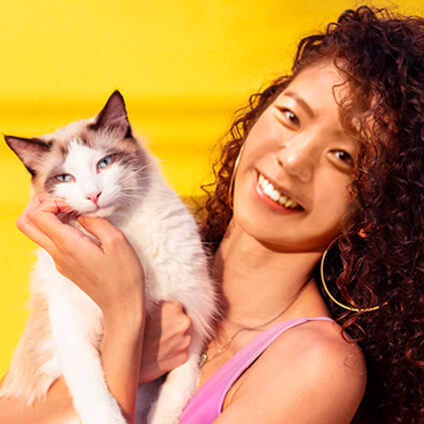
With over five years of specialized experience as an animal writer, my expertise lies in cat nutrition, health, behavior, grooming, and training. I am dedicated to delivering helpful and informative content that caters to the well-being of our feline friends. My primary goal is to empower pet owners with knowledge and ensure our feline companions thrive in health and happiness. In my free time, I love volunteering at local cat rescue centers.
